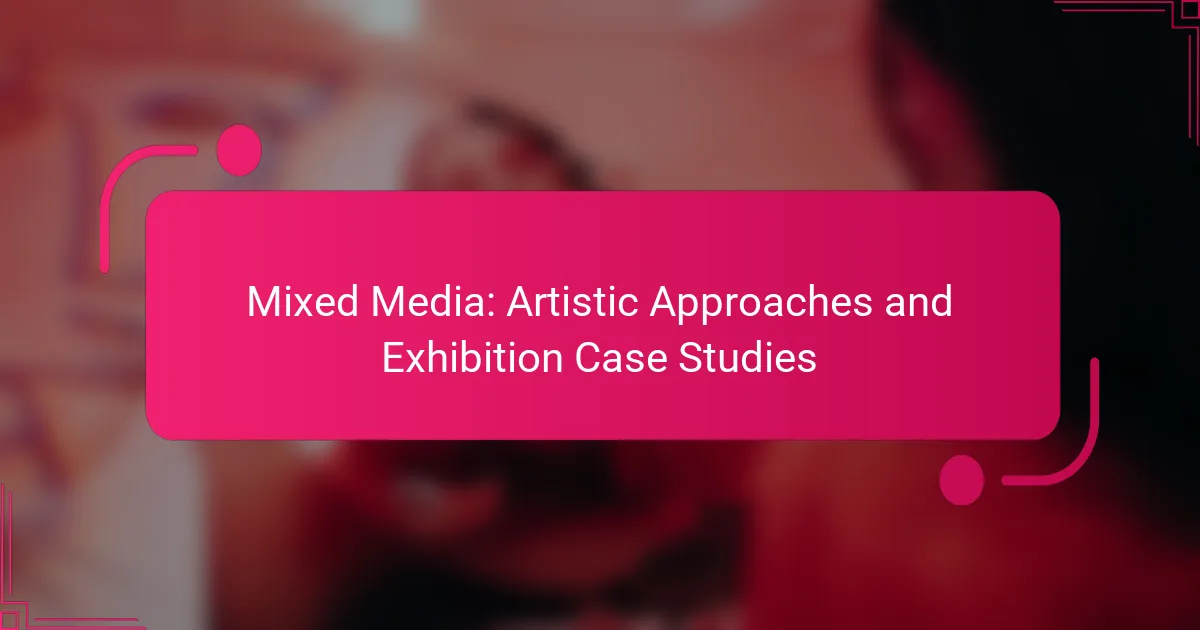Mixed media art offers a unique platform for artistic expression by blending diverse materials and techniques. This article explores the fundamental principles of mixed media, its historical influences, various artistic approaches, notable artists, and effective exhibition strategies. Case studies will illustrate how innovative presentations engage audiences and redefine traditional art experiences. Additionally, we will discuss the challenges artists face in this dynamic field and the importance of experimentation and cohesive themes.
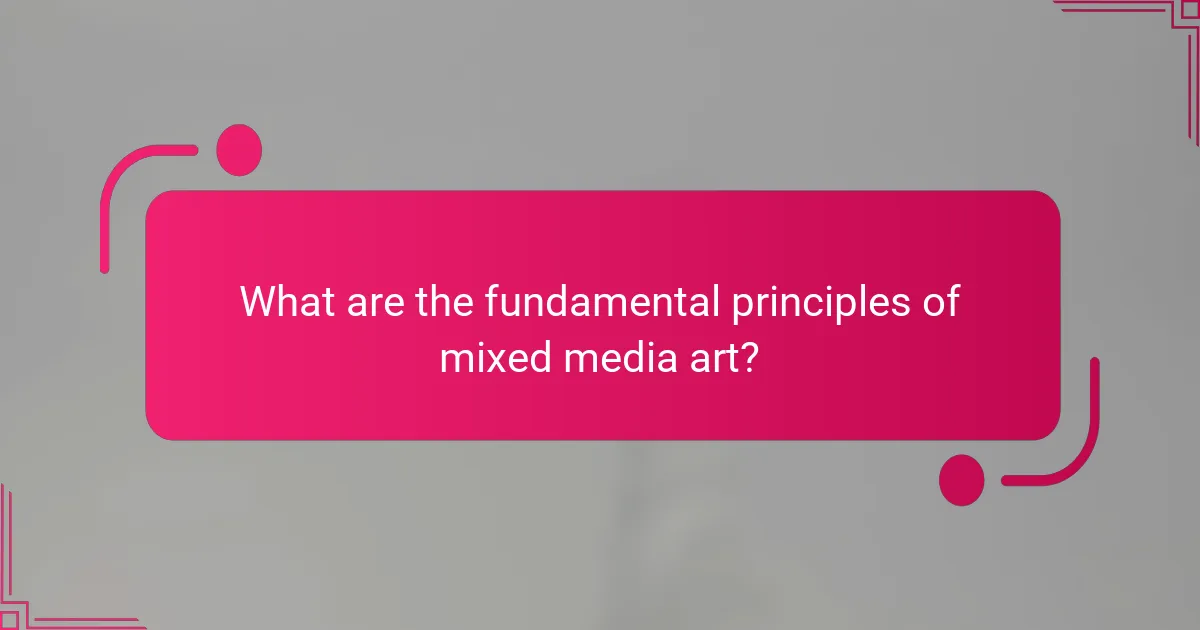
What are the fundamental principles of mixed media art?
Mixed media art combines various artistic approaches to create diverse visual experiences. Fundamental principles include the integration of different materials, the exploration of texture and form, and the emphasis on personal expression. Artists often utilize unconventional elements, such as found objects or digital media, to challenge traditional boundaries. This approach fosters innovation and encourages viewers to engage with art in new ways.
How does mixed media differ from traditional art forms?
Mixed media combines various artistic techniques, while traditional art forms typically focus on singular methods. Mixed media allows for a blend of materials, such as paint, collage, and found objects, enhancing creativity and expression. In contrast, traditional art forms like painting or sculpture adhere to established techniques and materials. This versatility in mixed media fosters innovation, making it a distinct approach in contemporary art.
What are the common materials used in mixed media?
Common materials used in mixed media include paper, paint, fabric, and found objects. These elements allow artists to create diverse textures and forms, enhancing visual storytelling. Additionally, digital components and photography are increasingly incorporated, expanding creative possibilities. Each material contributes unique qualities, making mixed media a versatile artistic approach.
Why is experimentation important in mixed media practices?
Experimentation is crucial in mixed media practices as it fosters innovation and creativity. By exploring diverse materials and techniques, artists can discover unique expressions and challenge traditional boundaries. This approach enhances artistic development and encourages a deeper engagement with the audience. Experimentation also allows for the integration of various art forms, resulting in dynamic and multifaceted works that reflect contemporary issues and personal narratives.
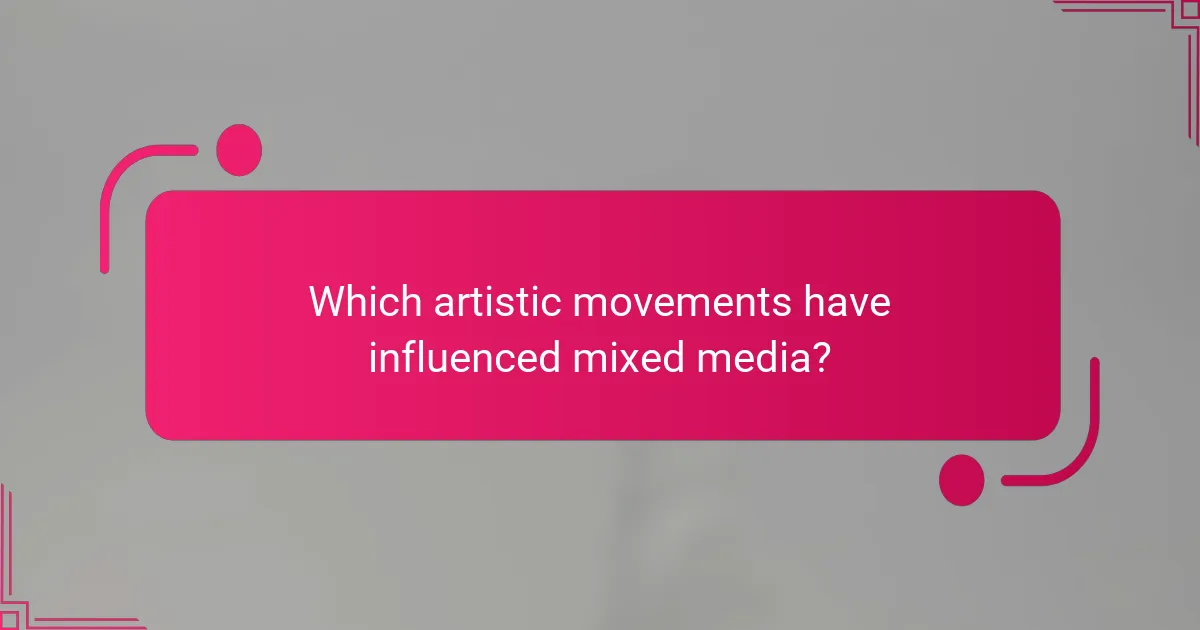
Which artistic movements have influenced mixed media?
Mixed media has been influenced by several artistic movements, notably Surrealism, Dadaism, Cubism, and Abstract Expressionism. Surrealism introduced dream-like imagery and unconventional materials, while Dadaism emphasized anti-art and chance elements. Cubism fragmented forms, encouraging diverse perspectives, and Abstract Expressionism focused on spontaneous expression through varied media. Each movement contributed unique techniques and philosophies that shaped contemporary mixed media practices.
How did Dadaism contribute to mixed media techniques?
Dadaism significantly influenced mixed media techniques by promoting the integration of diverse materials and forms. This movement challenged traditional artistic boundaries, encouraging artists to experiment with collage, assemblage, and found objects. Dadaists like Marcel Duchamp and Hannah Höch utilized unconventional materials, blurring the lines between art and everyday life. Their innovative approaches paved the way for future movements and contemporary mixed media practices, emphasizing the importance of context and viewer interaction. As a result, Dadaism’s legacy is evident in the diverse artistic expressions seen in modern galleries.
What role did Surrealism play in the evolution of mixed media?
Surrealism significantly influenced the evolution of mixed media by encouraging experimentation and the integration of diverse materials. This movement promoted the fusion of unexpected elements, enabling artists to explore subconscious themes. Surrealist practices, such as collage and assemblage, expanded artistic boundaries and inspired contemporary mixed media approaches. The incorporation of photography, painting, and found objects became a hallmark of mixed media, reflecting the unique attribute of Surrealism’s emphasis on dreamlike narratives and irrational juxtapositions. As a result, mixed media emerged as a versatile and dynamic form of artistic expression, rooted in Surrealism’s innovative spirit.
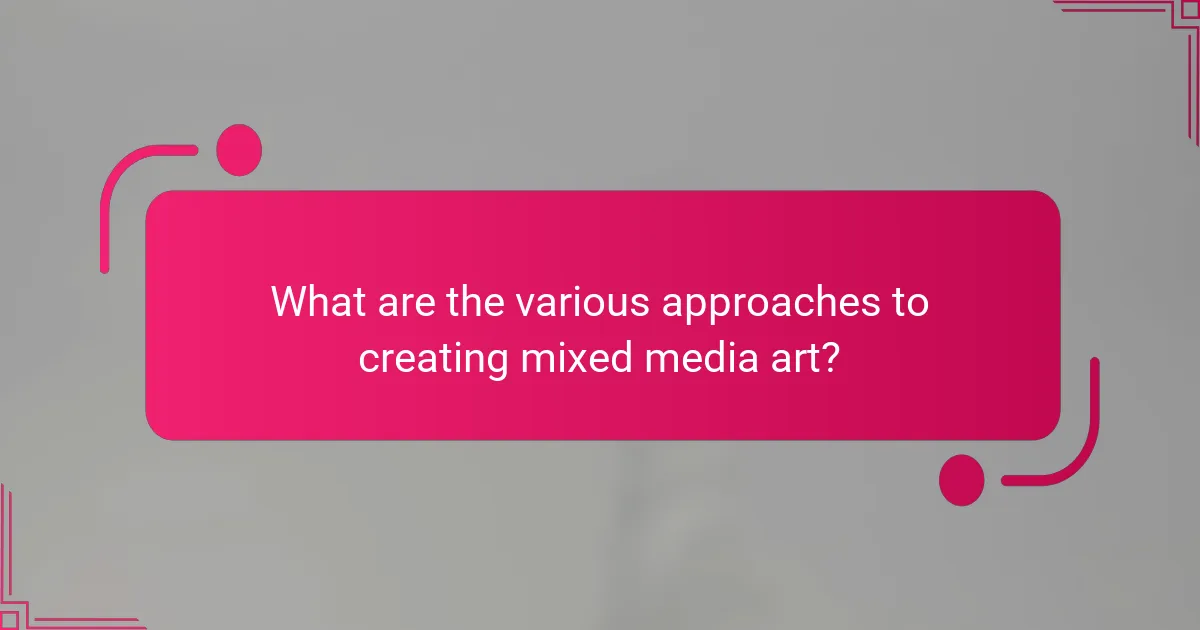
What are the various approaches to creating mixed media art?
Mixed media art can be created through various approaches that blend different materials and techniques. Key methods include collage, assemblage, and installation art.
Collage involves combining various materials such as paper, fabric, and images to create a new composition. Assemblage incorporates three-dimensional objects, often found or repurposed items, to form a cohesive artwork. Installation art transforms a space using mixed media, engaging viewers in an immersive experience.
Artists may also explore digital mixed media, integrating technology with traditional methods. Each approach offers unique attributes, allowing for diverse expressions and interpretations in mixed media art.
How do artists integrate different media in their work?
Artists integrate different media by combining traditional techniques with contemporary practices to create innovative works. This approach allows for the exploration of diverse textures, colors, and forms. For instance, an artist may blend painting with sculpture, utilizing materials like acrylics, wood, and found objects. This fusion enhances the overall narrative and emotional impact of the artwork. Additionally, exhibitions often showcase mixed media to highlight the versatility of artistic expression and engage audiences in new ways. Through this integration, artists can challenge conventional boundaries and invite viewers to experience art from multiple perspectives.
What are the benefits of layering techniques in mixed media?
Layering techniques in mixed media enhance depth, texture, and visual interest. These methods allow artists to combine diverse materials, creating dynamic compositions. The interplay of layers can evoke emotion and narrative, engaging viewers more effectively. Additionally, layering can facilitate experimentation, enabling unique artistic expressions and innovative approaches.
How can digital tools enhance mixed media art?
Digital tools significantly enhance mixed media art by expanding creative possibilities and streamlining production. Artists can utilize software for digital painting, photo manipulation, and 3D modeling, integrating various media forms seamlessly. These tools facilitate experimentation, allowing for rapid iteration and the blending of traditional and contemporary techniques. Additionally, digital platforms enable wider audience reach through online exhibitions and social media sharing, enhancing visibility and engagement with the art community.
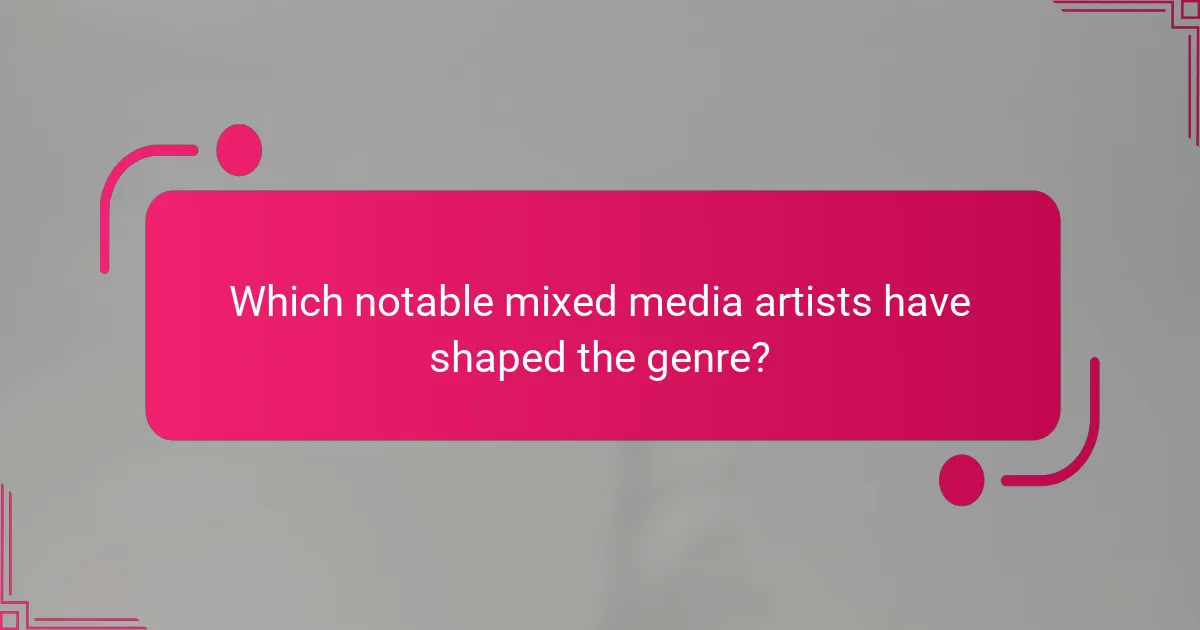
Which notable mixed media artists have shaped the genre?
Notable mixed media artists who have shaped the genre include Robert Rauschenberg, Jasper Johns, and Yoko Ono. Rauschenberg’s innovative combines merged painting and sculpture, while Johns’ flag motifs challenged traditional representation. Ono’s conceptual art expanded the boundaries of mixed media through performance and installation. Each artist contributed unique attributes that defined the evolution of mixed media art.
What unique attributes distinguish the work of specific mixed media artists?
Unique attributes that distinguish specific mixed media artists include their innovative use of materials, distinct thematic explorations, and signature techniques. For instance, artist Robert Rauschenberg is known for combining found objects with paint, creating a tactile experience. In contrast, Anselm Kiefer employs heavy textures and symbolic elements to convey historical narratives. Each artist’s approach reflects personal experiences and cultural contexts, making their work unique within the mixed media realm.
How have regional influences shaped the practices of mixed media artists?
Regional influences have significantly shaped mixed media artists’ practices, fostering unique styles and techniques. Cultural heritage, local materials, and socio-political contexts inform their creative expressions. For instance, artists in urban settings often incorporate found objects reflective of their environment, while rural artists may draw from nature and traditional crafts. Additionally, regional art movements inspire collaborative projects that highlight community narratives, creating a distinct identity within mixed media. This interplay of local culture and artistic innovation enriches the global art landscape, showcasing diverse perspectives.
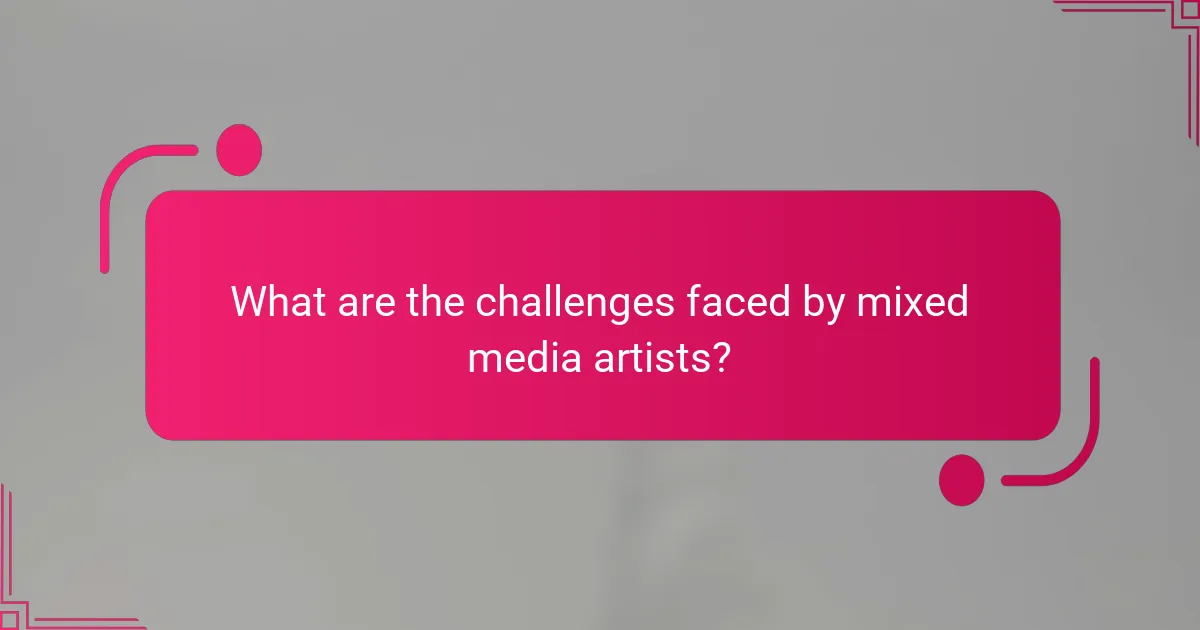
What are the challenges faced by mixed media artists?
Mixed media artists face various challenges, including material limitations, audience perception, and the complexity of integrating diverse techniques. These factors can hinder creative expression and limit the accessibility of their work.
Material limitations often arise from the need to source various supplies that can be costly or difficult to obtain. Audience perception challenges stem from mixed media’s unconventional nature, which may not resonate with traditional art audiences. The complexity of integrating different techniques can lead to difficulties in achieving a cohesive final piece, impacting the artist’s vision.
Moreover, the evolving nature of mixed media art requires artists to continuously adapt and innovate, which can be both a challenge and an opportunity for growth.
How do artists overcome common technical difficulties?
Artists overcome common technical difficulties in mixed media by experimenting with materials, adapting techniques, and collaborating with others. They often embrace challenges as opportunities for creativity. For example, using unconventional tools can lead to unique textures and effects. Additionally, seeking feedback from peers fosters innovation and problem-solving. This approach encourages resilience and continuous learning, essential traits for artistic growth.
What role does audience perception play in mixed media exhibitions?
Audience perception significantly influences the success of mixed media exhibitions. It shapes how artworks are interpreted and experienced, ultimately affecting engagement and emotional response.
Factors such as cultural background, personal experiences, and social context play crucial roles in shaping audience perception. For instance, diverse interpretations can arise from the same piece, reflecting unique viewer perspectives.
Additionally, the arrangement and presentation of mixed media installations can enhance or hinder audience engagement. Thoughtful curation encourages deeper exploration, while chaotic displays may lead to confusion.
Understanding audience perception allows artists and curators to create more impactful exhibitions that resonate with viewers on multiple levels. Engaging with audience feedback can further refine future exhibitions, ensuring they meet the evolving expectations of diverse audiences.
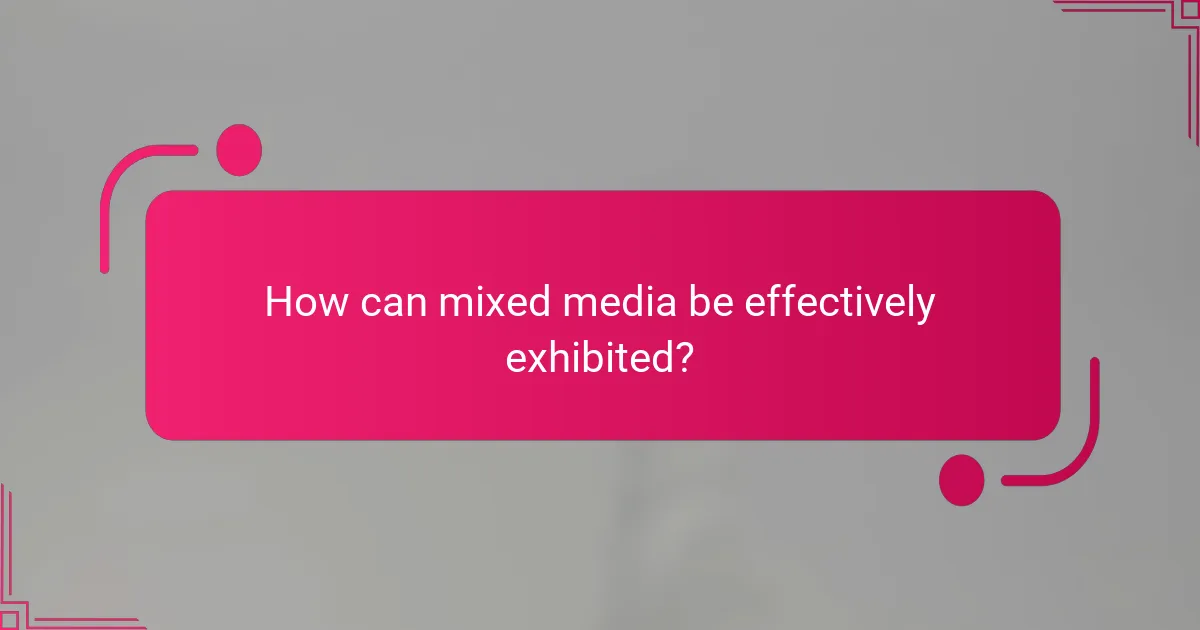
How can mixed media be effectively exhibited?
Mixed media can be effectively exhibited through thoughtful curation and interactive elements. Incorporating diverse materials engages viewers and enhances their experience. Case studies show that integrating technology, such as augmented reality, can elevate the viewer’s connection to the artwork. Additionally, creating immersive environments encourages exploration and interaction, making the exhibition memorable.
What are the key considerations for curating mixed media exhibitions?
Key considerations for curating mixed media exhibitions include selecting diverse materials, ensuring cohesive themes, and engaging audiences. Curators should evaluate the spatial arrangement to enhance viewer experience. Collaborating with artists can bring unique perspectives, enriching the exhibition’s narrative. Additionally, incorporating technology can create interactive elements that captivate visitors.
How do exhibition spaces impact the presentation of mixed media art?
Exhibition spaces significantly enhance the presentation of mixed media art by influencing viewer engagement and interpretation. The design, lighting, and layout of these spaces can accentuate the diverse materials and techniques used in mixed media works. For example, a well-curated exhibition can provide context that deepens the audience’s understanding of the artist’s intent and the thematic elements of the artwork. Unique attributes like spatial arrangement can create immersive experiences, allowing viewers to interact with the art in dynamic ways. Additionally, the choice of exhibition space can impact the perceived value and reception of mixed media art, ultimately shaping its narrative within the art community.
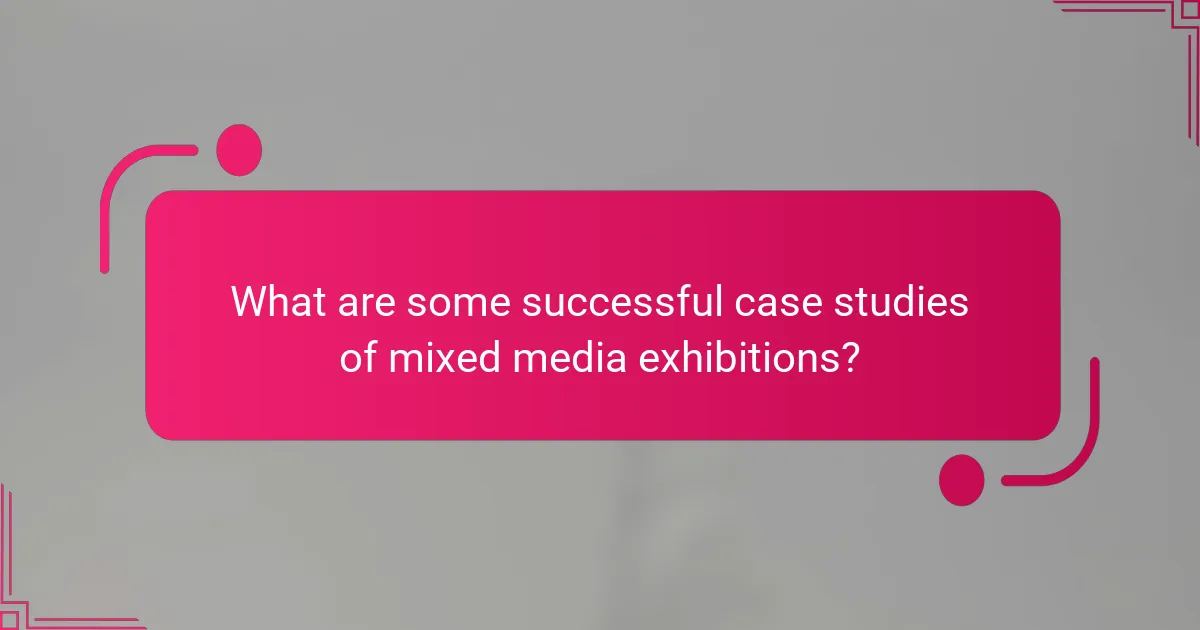
What are some successful case studies of mixed media exhibitions?
Successful mixed media exhibitions often blend diverse artistic techniques to create immersive experiences. Notable examples include:
1. “The Obliteration Room” by Yayoi Kusama, which transformed a white room into a vibrant space through audience participation.
2. “The Infinite Bridge” by Olafur Eliasson, which used light and reflection to enhance viewer interaction with the environment.
3. “The Artist’s Room” at Tate Modern, showcasing various media from video installations to sculpture, emphasizing the versatility of contemporary art.
4. “TeamLab Borderless” in Tokyo, where digital art and physical space merge, creating a dynamic, interactive experience.
These case studies illustrate how mixed media can engage audiences and redefine traditional exhibition formats.
Which mixed media exhibitions have received critical acclaim?
Several mixed media exhibitions have received critical acclaim for their innovative approaches. Notable examples include “The Artist is Present” by Marina Abramović, which engaged audiences through performance art, and “Yayoi Kusama: Infinity Mirrors,” celebrated for its immersive installations. Another significant exhibition is “The Body Remembers,” which explored themes of memory and identity through multimedia works. These exhibitions exemplify the unique ability of mixed media to provoke thought and emotional response.
How did specific case studies address audience engagement?
Case studies in mixed media art have effectively enhanced audience engagement through interactive installations and immersive experiences. For example, the “TeamLab Borderless” exhibition utilized digital technology to create an evolving art environment, allowing visitors to interact with the artwork. This unique approach fostered a sense of connection and participation, increasing visitor retention and satisfaction. Additionally, the “The Obliteration Room” by Yayoi Kusama invited guests to contribute by adding stickers, creating a collaborative art piece that engaged audiences actively. These case studies illustrate the impact of innovative artistic methods on audience involvement.
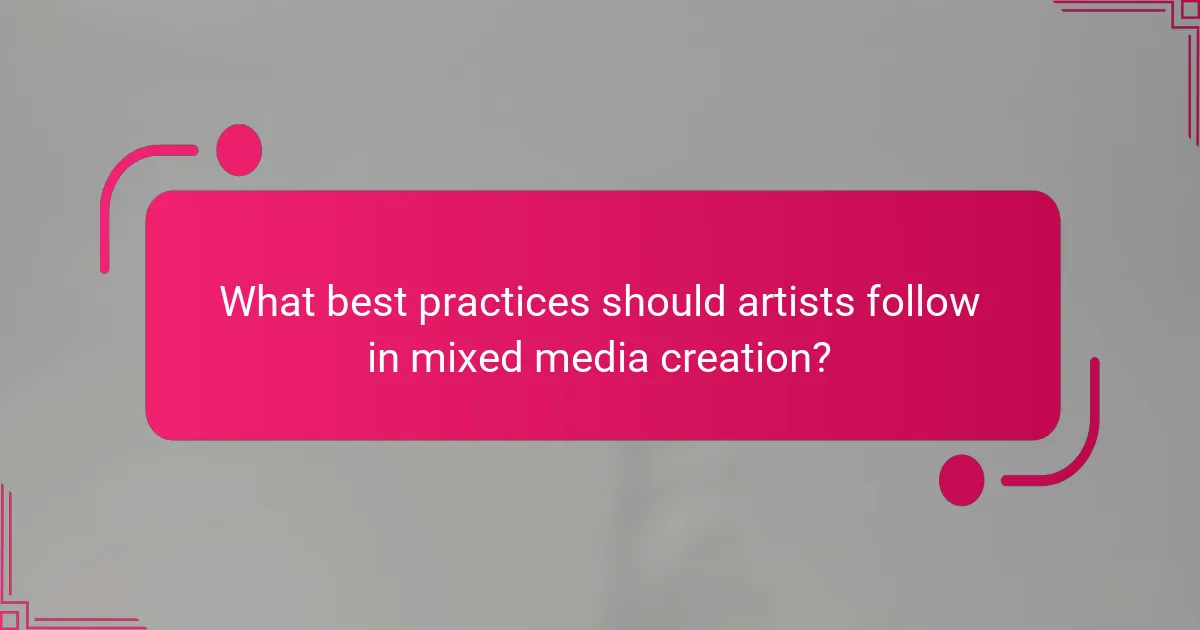
What best practices should artists follow in mixed media creation?
Artists should prioritize experimentation, embrace diverse materials, and maintain a cohesive theme in mixed media creation. These practices enhance creativity and engagement.
1. Experimentation: Explore various techniques and materials to discover unique expressions.
2. Material Diversity: Combine traditional and unconventional materials for richer textures and effects.
3. Cohesive Theme: Ensure all elements align with a central concept to create a unified piece.
4. Layering Techniques: Utilize layering to add depth and complexity to the artwork.
5. Audience Engagement: Consider the viewer’s experience and interaction with the piece.
6. Documentation: Keep a record of processes and inspirations to inform future projects.
What common mistakes should be avoided in mixed media projects?
Common mistakes in mixed media projects include neglecting planning, overcomplicating the design, ignoring material compatibility, and failing to consider audience engagement. These errors can hinder the project’s effectiveness and impact. Proper planning ensures cohesive integration of various media forms. Simplifying designs helps maintain clarity and focus. Ensuring materials work well together prevents structural issues. Engaging the audience through thoughtful presentation enhances the overall experience.
How can artists find their unique voice within mixed media?
Artists can find their unique voice within mixed media by experimenting with diverse materials and techniques. Engaging in this exploration allows artists to discover personal styles and themes. Collaborating with other artists can provide fresh perspectives and inspire new approaches. Additionally, reflecting on personal experiences and emotions can inform the creative process, leading to distinctive works. Embracing mistakes and unexpected outcomes can also foster innovation and authenticity in their artistic expression.
